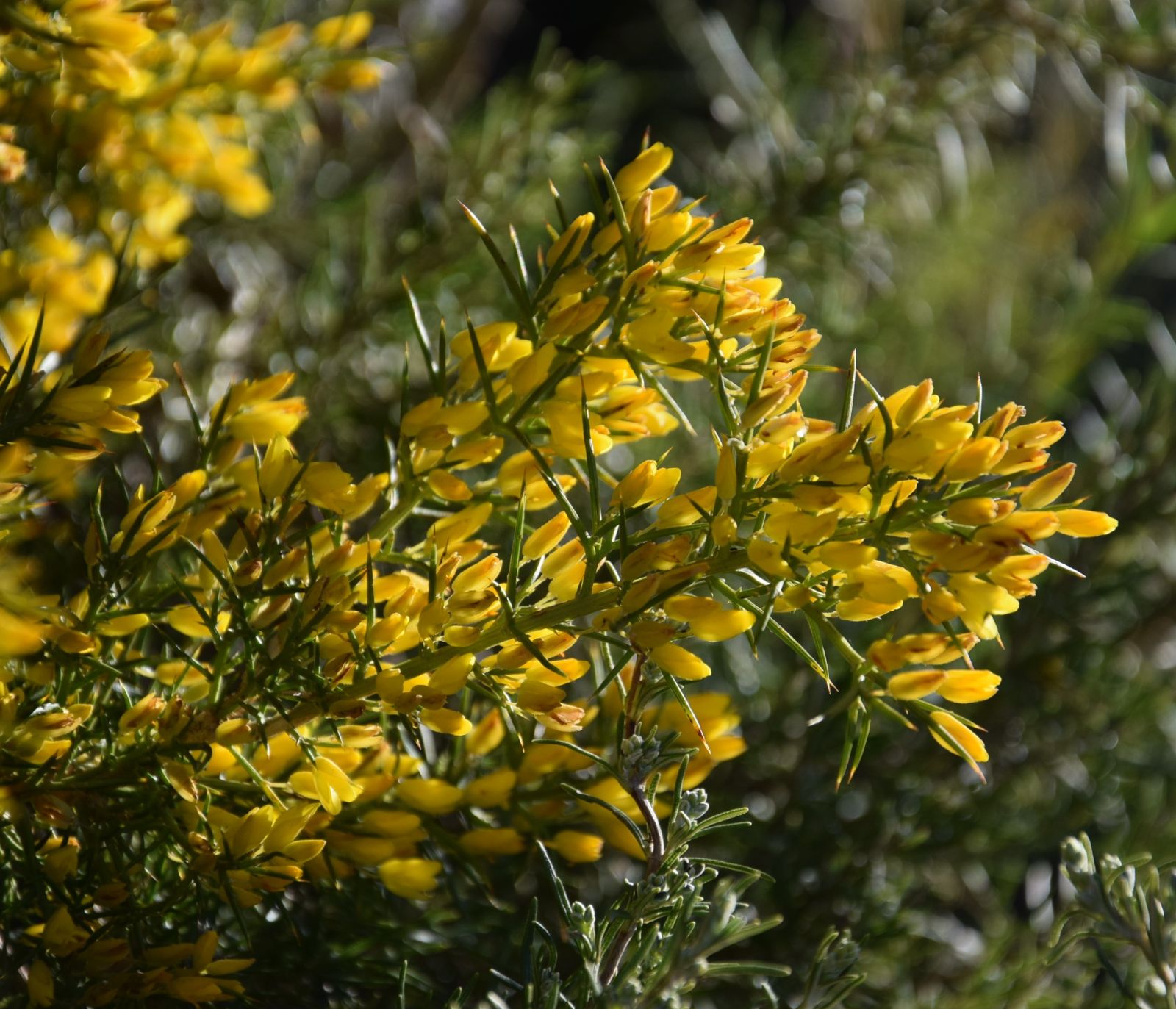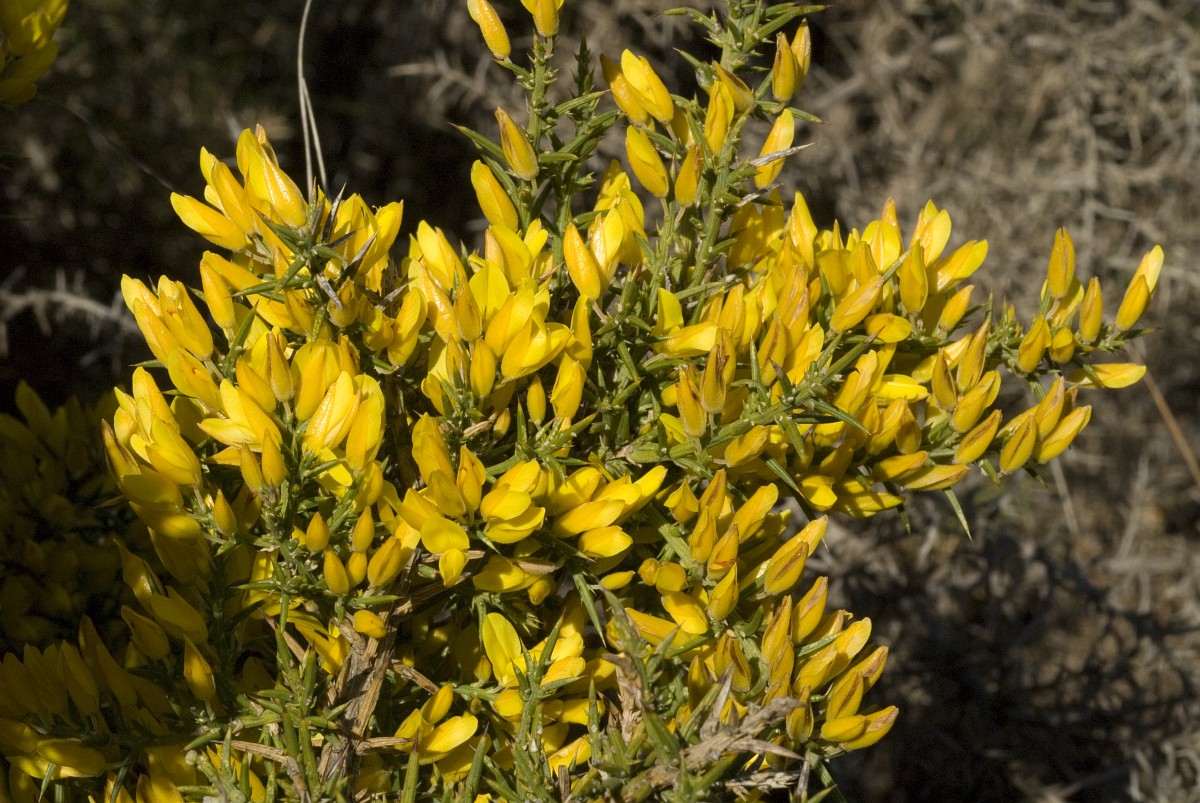Ulex parviflorus
Sponsor
Kindly sponsored by
a member of the International Dendrology Society
Credits
Julian Sutton (2022)
Recommended citation
Sutton, J. (2022), 'Ulex parviflorus' from the website Trees and Shrubs Online (treesandshrubsonline.
Genus
Common Names
- Small-flowered Gorse
- Mediterranean Gorse
Shrub or subshrub to 1.5 m, densely or loosely branched, depending on environment. Branchlets pale green, glabrous or finely pubescent. Primary spines to 3 cm, straight or slighty curved, alternate; secondary spines abundant to almost absent, to 1 cm, variably arranged but not bunched together near the base. Primary phyllodes to 4 mm long, rigid, spiny, triangular-lanceolate to linear-lanceolate, glabrous; secondary phyllodes to 2.5 mm , lanceolate. Bracteoles 0.5–2 × 0.5–1 mm; pedicels 2–4.5 mm. Calyx (6.5–)7.5–9 mm, glabrescent or pubescent with long, curved hairs; upper lip 2–3 mm wide, rounded or narrowed at base; lower lip narrowed at base. Banner 8.5–11 × 4.5–7 mm, glabrous, equalling or slightly exceeding the calyx; wings 6.5–9 × 2–3.3 mm; keel 8.5–10 × 2–3 mm, longer than wings. Fruit 8.5–9 × 4–4.5 mm, oval-oblong, with 1–2 seeds. Seeds 2.5–3.5 × 1.5–2 mm. 2n=32 (diploid). (Cubas 1999).
Distribution Algeria France Morocco Portugal Spain
Habitat Mediterranean shrublands usually on basic soils, 0–1900 m asl.
USDA Hardiness Zone 8-9
RHS Hardiness Rating H4
Conservation status Not evaluated (NE)
Of the more Mediterranean Ulex species, U. parviflorus is the most likely to be found cultivated in our area, albeit rarely. Unlike most, its natural range extends beyond the Iberian Peninsula into North Africa and France. Its flowers are smaller than those of U. europaeus and U. gallii, roughly equalling those of U. minor, the plant tends to be paler green than any of these familiar species, and it differs ecologically in being calcicole. In southern Spain it usually flowers between November and February (M.J. Holguin, pers. comm. 2022).
Like U. europaeus it is a highly flammable plant which retains dry, dead branchlets. It often grows in fire-prone habitats yet unlike Common Gorse it does not resprout after burning; instead, seed germination is stimulated by fire. Studies on this species (Pausas et al. 2012) support the ‘kill thy neighbour’ hypothesis for evolution of plant flammability. This suggests that flammability may paradoxically increase an individual’s evolutionary fitness if burning both kills less flammable neighbours and increases recruitment opportunities for the individual’s own offpring (Bond & Midgley 1995).
Delineation of this important species varies. Certainly, only the type subsp. parviflorus is widespread. Flora Iberica (Cubas 1999) also recognizes subsp. rivasgodayanus Cubas, a much hairier plant from the Sierra de Almijara, Southern Spain. Others have included further taxa as subspecies of U. parviflorus. Flora Europaea (Tutin et al. 1968) took a broad species concept, including the plants we treat (under Ulex Iberian Species) as U. eriocladus (tetraploid) and jussiaei (hexaploid) as subspecies of U. parviflorus. Plants of the World Online (Royal Botanic Gardens, Kew 2022) treats the diploid U. airensis (again see Ulex Iberian Species) as a subspecies.
Sometimes grown in gardens and offered by nurseries in Mediterranean Europe, U. parviflorus is rare in our area, but is worth trying in dry, sunny, mild sites, especially on calcareous soils. Two accessions, one of known wild origin, are recorded at Meise Botanic Garden, Belgium (Plantcol 2022).



